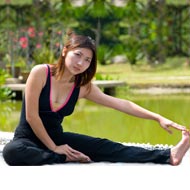- Aromatherapy (36)
- Benefits of Yoga (282)
- Home Remedies (1087)
- massage therapy (9)
- Preventive Therapy (135)
- Running (41)
- Skin Care (15)
- Stress Relief (25)
- Stretching (5)
- walking (33)
- Womens Health (14)
- Yoga Benefits for Pregnant Women (16)
- Yoga Benefits for Students (3)
- Yoga for Children (11)
- Yoga for Holistic Living (37)
- Yoga for Midlife Crisis (3)
- Yoga for Senior Citizens (2)
- Yoga for the Workplace (1)
- Yoga Health Tips (185)
- Yoga Practice during Menstruation (5)
Chinese Taoist Yoga: Ancient Exercises From Tai Chi

What are the principles of taoist yoga
Chinese Taoist Yoga is a system of movement and stretching exercises which help coordinate your breathing with the help of specific postures and movements as well as certain meditative practices based on a deep, intense philosophy. Even though Taoist Yoga includes certain complex, ancient exercises from Tai Chi traditions, it is really an extremely simple system, which can be practiced by any and everyone, regardless of gender, size, age, health status, or previous experience.
Taoist Yoga is a simple, yet highly versatile form of Yoga, simply because it is founded on certain basic principles, which underlie the real practice of Yoga and Tai Chi. Once you have secured a foothold in the vital principles of Taoist Yoga, you can easily apply them to almost any situation and circumstance in life. This is because Taoist Yoga is, essentially, a means of fully understanding your body and mind, as a result of which you are able to create a personal practice, consisting of postures, movements and activities specific to your body's interests, and needs.
Guiding principles of Chinese Taoist Yoga
- Ahimsa (non violence): Many a time, you may not be able to accept your abilities and, hence, find yourself unable to build a solid foundation for yourself, based on your intrinsic needs and proficiency. Basically, Chinese Taoist Yoga uses ahimsa or a non-violent approach to all practices, with a view to calm down the mind and the ego and let the mind and body adapt to different postures and movements so that they may change and grow smoothly, easily and effortlessly.
- Macrocosm / Microcosm: Essentially, Taoist Yoga teaches us that everything in nature is interconnected and, further, states that everything small reflects in the big, and the big in the small. You can also look at it as your spirit reflected in your mind, your mind reflected in your body, and your body reflected in the environment. If you are able to understand that your mind affects the comfort levels of your body and that your body affects the soundness of your mind, you will be more a lot more aware of your physical and mental states in Yoga class as well as in other activities of everyday life.
- Your breath is your ultimate teacher: We often tend to ignore this undeniable truth and, usually, get on with our day to day routines without paying any attention at all to our breathing. Having a little more knowledge, understanding and awareness of our breathing will help intensify our understanding of ourselves.
- Postures and movements are like medicine: You must know how to select all exercises and postures carefully in a manner that they address your individual requirements. The fundamental part of the practice is to learn and discover which parts of your body are tight and tense and require special attention.
- RSS Feeds -
- All posts
- All comments
- Treating Eczema with Acupuncture Eczema is a skin condition that falls under the category of atopic dermatitis...
- Controlling Qi with or without Needles According to Traditional Chinese Medicine (TCM), the ‘Qi’ or ‘...
- Ashiatsu Barefoot Massage Ancient and alternative therapy methods are growing popular as a means to res...
- Ancient Thai Yoga Massage Therapy Unknown to most, the ancient tradition of Thai Massage actually originated in...